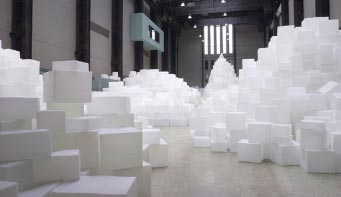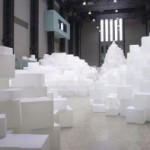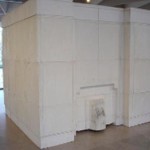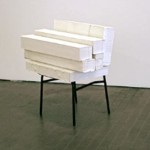In 1993 I visited Chicago for the first time with my younger brother Robert. We had a good friend who had just moved there and went to see him, the town and have some fun. During the day between visits to attractions like the Chicago Mercantile Exchange and the Billy Goat Tavern we visited the Museum of Contemporary Art in the center of the city in a small shared building (the MCA is now in a big new building looking out on the lake). The two exhibits featured were a young British sculptor, Rachel Whiteread and an established american painter Susan Rothenburg.
Entering Whiteread’s exhibition space first, we were greeted by a full sized mattress made of rubber, Untitled (double amber bed) (1991) slouching against the wall heavily bending from its own weight. There was a group very animated small sculptures made from pouring plaster into hot water bottles. The strange bulbous shapes were unexpectedly anthropomorphic (think headless doll body; a fact reinforced by the title “Torso”) and detailed enough to show seams and embossed writing from inside the water bottles. What they revealed was the conceptual brilliance of Whiteread’s work–she had found and captured a completely “new” form–even though we had seen hot water bottles our whole lives. The breakthrough was to cast the void, the space hidden inside the bottles, and replace what we knew of the outside with what she had discovered, solidified and exposed.
I was in the middle Graduate school for sculpture at the time using similar processes to cast bronze sculptures. For two years I had been making plaster and rubber molds for waxes and resin-bonded sand molds for direct casting. After seeing that casting and molding was the process Whiteread used to “flip” the form, I looked closer at all the other work in the exhibit. The rubber bed was actually a cast of the space below a bed (which was about the same thickness as a mattress) and the reversed upholstered “buttons” were raised pyramids with concave discs, inverted from their normal recessed position. I was dazzled. What a spatial mind game.
I stuck my face under and around the sides of every sculpture in the room and felt exhilarated that the sculptor’s complaint “I like the mold better than the cast sculpture” had been embraced by an artist around my age. But since I was the only artist in the group we soon to exited the museum (the Rothenburg horse paintings were not a big hit) and found a cold beer not too far away that everyone agreed on. A month or two later back in Atlanta, the Turner Prize was announced and the artist selected was Rachel Whiteread.
I shared my recollection with the artist at her opening in Rome (I left out the beer drinking). The Rome gallery reception must have seemed refreshingly low key for the artist compared with New York and London opening night mob scenes and she mixed easily with Italian collectors, artists and American students from a nearby College. When I spoke to Whiteread, she was gracious and joked that I had a good memory for that was so long ago. I complimented her on the current work and mentioned that I had worked with Christoph Grunenberg at the ICA, Boston and she smiled and spoke fondly of her relationship with the former ICA curator ( Now Tate Liverpool Director) and Boston’s ICA.
It was a thrill to meet and talk to her and other than the short story about Chicago I did not really discuss her new work other than the usual congratulatory “Brava!” I visited the Rome exhibition again a week later and confirmed what I had detected at the opening. Whiteread’s new sculpture was moving in a very different direction formally from her early works, but she seems to be revisiting much of the autobiographical content upon which the early work was based. Having followed Whiteread's development from that early exhibition and having had a similar technical training, I decided to give a more thorough review and comparison of this new body of work, its roots in the early sculpture shown in Chicago and why we should note the intentions underlying the varied strategies the artist has developed since 1993.
----
In her first solo exhibition in Italy, Rachel Whiteread expands and retools her investigations of spaces to consider the emotional impact of changing locations. The artist presented work that used her consistent formal vocabulary of plaster forms to generate a more personal, autobiographical narrative than any work she has produced since her own childhood room was the subject in Ghost (1990).
A statement produced for the The Galleria Lorcan O’Neill Roma exhibit states that this work was triggered by spending the last two years moving out of both her living and working spaces. The sight of having one’s entire life and history packed into boxes and crates must be somewhat cathartic. The response, surprisingly, was to have the entire “New Sculptures and Drawings” exhibition focus on one singular form: a cardboard box. In this context it was specifically a moving box, all sealed up and taped shut. The completely anonymous containers (except for one with embossed rings on the surface from wine bottles) varied in size from several as small as a lipstick box to one as big as a liquor case. There was also a series of drawings depicting cardboard rectangles piled next to images of stacking chairs and nesting tables clipped from magazines.
The repetition of a generic form and composing it into piles was a new trajectory for Whiteread’s work. The installation of Embankment (2005/2006) at Tate Modern’s Turbine Hall in London first introduced the cardboard box forms en masse. In Embankment the artist arranged 14,000 of the box forms to create a monumental maze of towering mountains and buildings that dwarfed the viewer and limited his or her movement and perspective. In the Lorcan O’Neill exhibit a very different, more intimate experience was generated using fewer and smaller versions of the same form. A text from the Tate exhibition stated that “The form of a cardboard box has been chosen because of its associations with the storage of intimate personal items and to invoke the sense of mystery surrounding ideas of what a sealed box might contain.”
Fundamentally this new direction was defined by a decision not to articulate the voids inside any of these boxes just to mold the inside surfaces. While the detailed plaster ( and in one case, hand painted bronze) perfectly recorded every surface texture of the internal flaps, corrugations and perforations, it was just like looking at the external surface of the sealed box. Therefore the encounter was closer to a confident inspection than the mind-bending discovery that Whiteread’s “space-reversing” sculptures usually elicited by surrounding–and thus revealing–its contents.
That decision profoundly changed the viewing experience from a formal/spatial discovery to an emotional, memory-based one: the feelings of loss, dislocation or nostalgia that were unavoidable when packing one’s entire life into anonymous boxes. The artist reduced the interest in the individual shapes through repetition which emphasized the position and accumulation of the components over the textural specifics or formal intrigue. This underpinned the psychological impact of slowly disappearing from a place, just as your processions gradually turn into bland boxes as you pack up everything to move out. The gallery became a room that was being packed up and emptied out and the space had a melancholy mood to it.
The artist used a similar tack to create a very different kind of anonymity and loss in her Holocaust Memorial in Vienna, Austria ( 2001). By casting hundreds and hundreds of books on shelves with their spines hidden (facing inward) the artist kept viewers attentive to the metaphorical and symbolic implications of the quantity of the books by obscuring any possibility of knowing what was in any one of them.
Another striking feature of this exhibit was the use of various platforms, found objects really, to display the cast plaster forms. Two chairs, two shelves, two medicine cabinets, a table, a stool, and a bookshelf held the multiple cast plaster works. The positive structures that Whiteread had previously used as molds and then removed to reveal the space that surrounded them were now sitting there as is functioning as ad hoc pedestals. The actual furniture from her studio had become just another object to wrap up and move or a flat surface to use as a landing spot for more boxes.
Rachel Whiteread has spoken for years, especially in her groundbreaking works Ghost (1990) and House (1991), about how memory and a general sense of loss that inhabited the “voids” that she cast because of their history. Now she had used the mystery of a sealed box to tempt the viewer with an unseen space. The material that she had used to make space more visible was now enclosing and obscuring space.
Returning to the content that she began her career with, Rachel Whiteread invigorates her new work with a poignant sense of mystery. In a recent interview Whiteread spoke of this directly saying, “I’m trying to work out a way of changing, of going backwards and remembering when I was working in the depths of the East End and cycling to the studio. The freshness of that time was easier, and I’m trying to find that place again.” The Rome exhibition was clearly more about change, the leaving of a place and uprooting things than about the specifics of that space or what was being moved. Our discovery of unexpected spaces was replaced by a reverent memorial to the past and the stocktaking that emotionally connects this work to the act of ending, packing up and starting something new. It is an interesting and symbolic move for the artist and presents a private counterpoint to Whiteread’s monumental public sculptures.
- Rachel Whiteread, Embankment installation view, Turbine Hall, Tate Modern, 2005.
- Rachel Whiteread, Ghost, Plaster, 1990.
- Rachel Whiteread, Sit, Plaster, wood and steel, 2006.
"New Sculptures And Drawings" is on view at Galleria Lorcan O’Neill Roma.
All images are courtesy of the artist and Galleria Lorcan O’Neill Roma.







